When I put up my photo gallery, Valerie asked, “How about a little insight on the Stillness?” 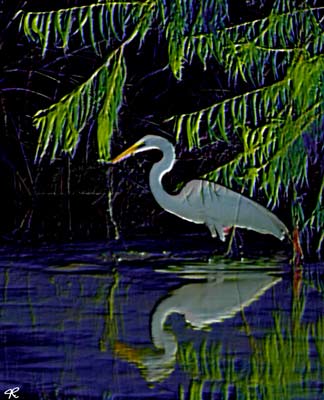
We had gone to Hermann Park one of many times, and shot pictures of birds on the water. It had more bushes in the background. I cropped it, and added 3 layers with different blend modes. I didn’t do any touch-up or painting on it. So it came out with a muted background and the colors I liked in the leaves(pretty much original color) and in the water(added with the layer blended as difference).
Valerie said, “It actually looks like Silk Screen to me. It is very beautiful. How do you do blending?”
Blending is very simple in Photoshop. You just choose from a menu of how to set the blend mode. It does the calculations for you. Each mode computes some difference in pixels between two layers and renders the pixel based on the type of mode. So some modes affect contrast and some affect the brightness, etc. I put the list at the bottom of this post.
Here’s a sequence you can see:
The original image
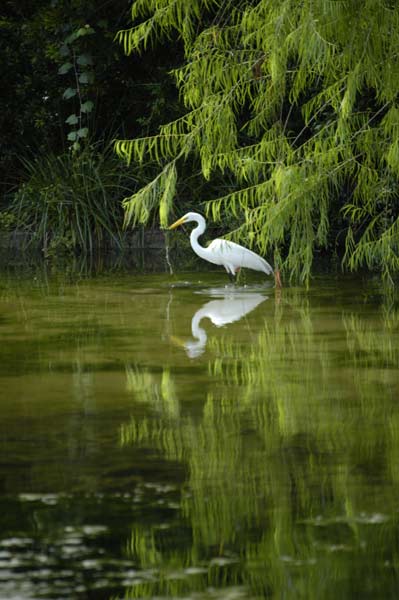
Then I cropped it and duplicated it to another layer. The new layer is embossed and set to blend mode luminosity.
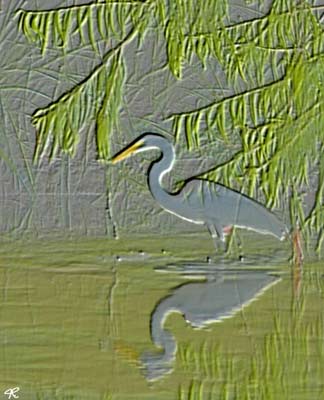
I didn’t quite like that, so I duplicated the original layer again and set the new layer to blend mode color burn with only 67% opacity.
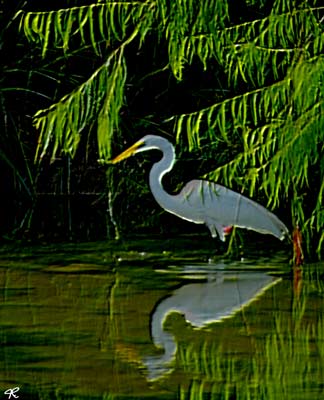
This was much better but not quite right, so I duplicated the original layer again and applied a filter called Find Edges (it ends up white except where the edges are and they are related to the color in the picture) and set the blend mode for that layer to difference and only 41% opacity. So that is the final result.

Since there are several layers, you can turn their visibility on or off and you get other results. Here’s how it looks without the color burn layer. (But I didn’t see this until later because I wanted the color burn layer.)
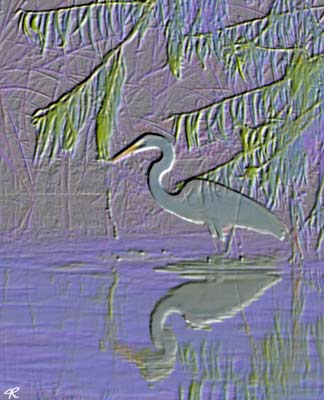
And one more with just the find edges, and no emboss layer. (Just to show you the possibilities.)

Of course, for each layer you have quite a few choices of blend mode and opacity and also what to do to it in order to emphasize different parts.
Here’s the complete image with no cropping. I’m starting to think it looks better this way, instead of cropped.
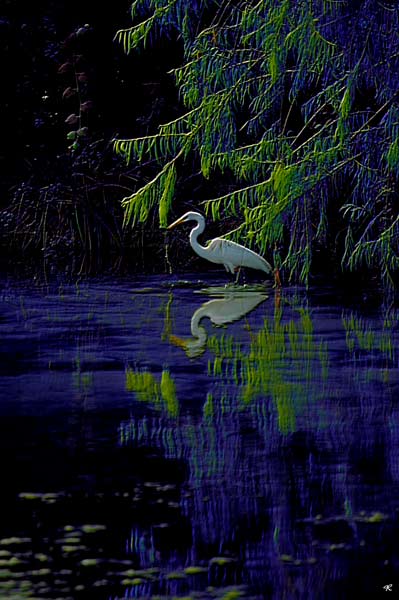
Here’s my chart of the blending modes, taken from the Photoshop help:
| blend color | mode | ||||
| white | <50% gray | >50% gray | black | ||
| unchanged | darkest of base and blend | black | Darken | Looks at the color information in each channel and selects the base or blend color – whichever is darker – as the result color. Pixels lighter than the blend color are replaced, and pixels darker than the blend color do not change. | |
| unchanged | base times blend color (always darker) | black | Multiply | Looks at the color information in each channel and multiplies the base color by the blend color. | |
| unchanged | darken by increasing contrast | Color Burn | Looks at the color information in each channel and darkens the base color to reflect the blend color by increasing the contrast. | ||
| unchanged | darken by decreasing brightness | Linear Burn | Looks at the color information in each channel and darkens the base color to reflect the blend color by decreasing the brightness. | ||
| white | lightest of base and blend | unchanged | Lighten | Looks at the color information in each channel and selects the base or blend color-whichever is lighter-as the result color. Pixels darker than the blend color are replaced, and pixels lighter than the blend color do not change. | |
| white | inverse blend times base (always lighter) | unchanged | Screen | Looks at each channel’s color informationand multiplies the inverse of the blend and base colors.The effect is similar to projecting multiple photographic slides on top of each other | |
| brighten by decreasing contrast | unchanged | Color Dodge | Looks at the color information in each channel and brightens the base color to reflect the blend color by decreasing the contrast. | ||
| brighten by increasing brightness | unchanged | Linear Dodge | Looks at the color information in each channel and brightens the base color to reflect the blend color by increasing the brightness. | ||
| base mixed with blend (multiply or screen) | Overlay | Multiplies or screens the colors, depending on the base color. The base color is not replaced but is mixed with the blend color to reflect the lightness or darkness of the original color. | |||
| lighter | lighten as dodge | darken as burn | darker | Soft Light | Darkens or lightens the colors, depending on the blend color. |
| white | lighten as screen (good for adding highlights) | darken as multiply (good for adding shadows) | black | Hard Light | Multiplies or screens the colors, depending on the blend color. |
| lighten by decreasing contrast | darken by increasing contrast | Vivid Light | Burns or dodges the colors by increasing or decreasing the contrast, depending on the blend color. | ||
| lighten by increasing brightness | darken by decreasing brightness | Linear Light | Burns or dodges the colors by decreasing or increasing the brightness, depending on the blend color. | ||
| darker replaced, lighter unchanged |
lighter replaced, darker unchanged |
Pin Light | Replaces the colors, depending on the blend color. | ||
| inverts | max brightness(base and blend) minus the other | unchanged | Difference | Looks at the color information in each channel and subtracts either the blend color from the base color or the base color from the blend color, depending on which has the greater brightness value. | |
| inverts | max brightness(base and blend) minus the other | unchanged | Exclusion | Creates an effect similar to but lower in contrast than the Difference mode. | |
| H: blend L: base S: base |
Hue | Creates a result color with the luminance and saturation of the base color and the hue of the blend color. | |||
| H: base L: base S: blend gray-unchanged |
Saturation | Creates a result color with the luminance and hue of the base color and the saturation of the blend color. | |||
| H: blend L: base S: blend |
Color | Creates a result color with the luminance of the base color and the hue and saturation of the blend color. | |||
| H: base L: blend S: base |
Luminosity | Creates a result color with the hue and saturation of the base color and the luminance of the blend color. This mode creates an inverse effect from that of the Color mode. | |||